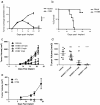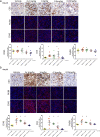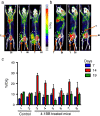PET imaging to non-invasively study immune activation leading to antitumor responses with a 4-1BB agonistic antibody
- PMID: 24829750
- PMCID: PMC4019904
- DOI: 10.1186/2051-1426-1-14
PET imaging to non-invasively study immune activation leading to antitumor responses with a 4-1BB agonistic antibody
Abstract
Background: Molecular imaging with positron emission tomography (PET) may allow the non-invasive study of the pharmacodynamic effects of agonistic monoclonal antibodies (mAb) to 4-1BB (CD137). 4-1BB is a member of the tumor necrosis factor family expressed on activated T cells and other immune cells, and activating 4-1BB antibodies are being tested for the treatment of patients with advanced cancers.
Methods: We studied the antitumor activity of 4-1BB mAb therapy using [(18) F]-labeled fluoro-2-deoxy-2-D-glucose ([(18) F]FDG) microPET scanning in a mouse model of colon cancer. Results of microPET imaging were correlated with morphological changes in tumors, draining lymph nodes as well as cell subset uptake of the metabolic PET tracer in vitro.
Results: The administration of 4-1BB mAb to Balb/c mice induced reproducible CT26 tumor regressions and improved survival; complete tumor shrinkage was achieved in the majority of mice. There was markedly increased [(18) F]FDG signal at the tumor site and draining lymph nodes. In a metabolic probe in vitro uptake assay, there was an 8-fold increase in uptake of [(3)H]DDG in leukocytes extracted from tumors and draining lymph nodes of mice treated with 4-1BB mAb compared to untreated mice, supporting the in vivo PET data.
Conclusion: Increased uptake of [(18) F]FDG by PET scans visualizes 4-1BB agonistic antibody-induced antitumor immune responses and can be used as a pharmacodynamic readout to guide the development of this class of antibodies in the clinic.
Keywords: 4-1BB; CD137; Colon cancer; Immune activating antibodies; PET imaging.
Figures





References
LinkOut - more resources
Full Text Sources
Other Literature Sources
Research Materials
